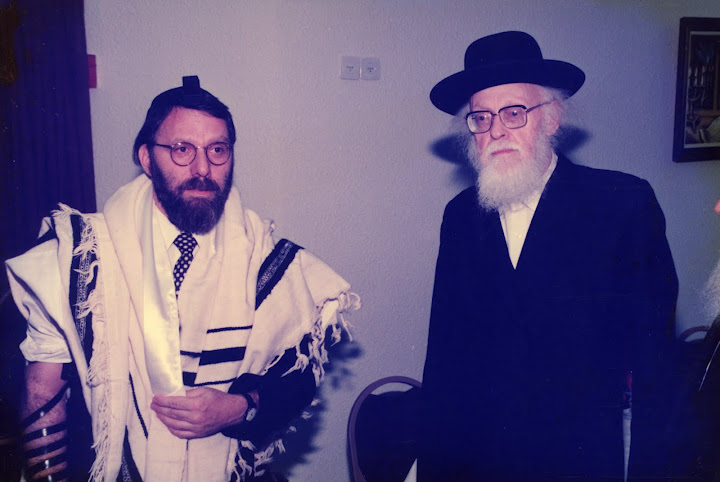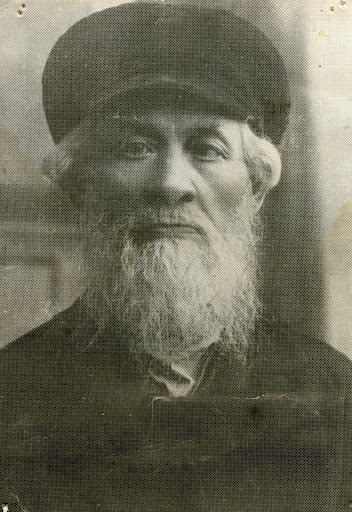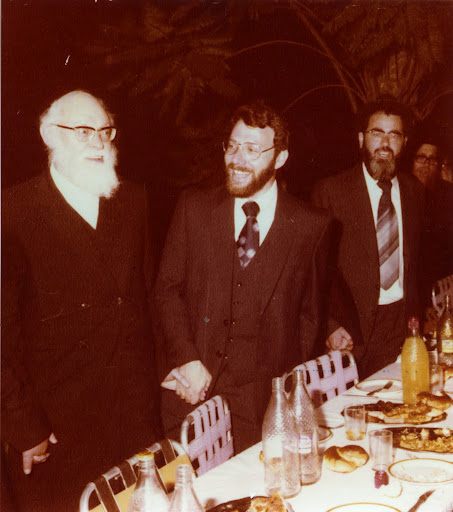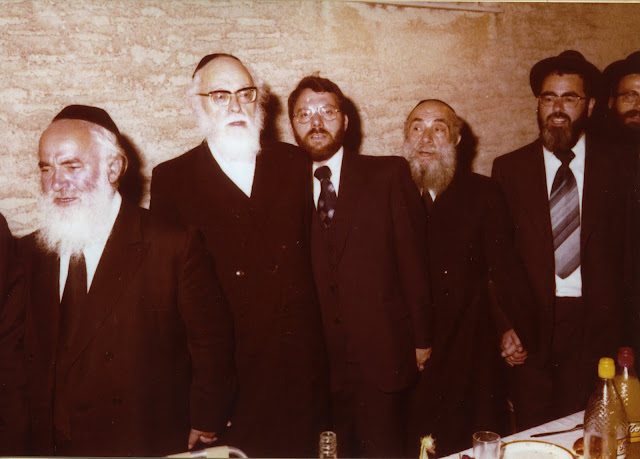[The pictures in this article are of the late Rabbi Yosef Shalom Elyashiv with his nephew, Rabbi Benji Levine]

Harav Elyashiv (referred to in this article as: HaRav) was born 102 years ago on Rosh Chodesh Nissan in the village of Shavik, in Lithuania.
His father was the Gaon Rabbi Avraham Elyashiv, the son-in-law of the famous Kabbalist, Rabbi Shlomo Elishov.
The birth of the Gaon occurred after 17 long years of barrenness, where the doctors gave no hope for the couple to ever hold a child of their own in their arms.
The Rebbetzin, Chaya Musha, went with tears to her father, the Baal “Leshem” telling him that the doctors have given her no hope for a child of her own.
Her father answered her that she will indeed give birth to a son who will light up the eyes of Israel.
And so it was.

The young Yosef Shalom was cherished by his grandfather, the “Leshem” who was also the one who discovered his genius capabilities and directed him in his Torah studies.
The child became so great in his Torah learning that there was no one who could teach him except for his father and grandfather.
When the Rav was 12, in 1924, his family moved to Israel and settled at the edge of Jerusalem’s Meah Shaarim neighborhood.
Here the Rav would live the rest of life, raising 12 children in a tiny 2 bedroom house.
His children are HaRav Shlomo, Rav of the Beit Midrash “Tifferet Bachurim”, the Rebbetzin Bat Sheva Kanievsky, z”l, Sarah Rochel – wife of Harav Yosef Yisroel Yisraelzohn, Dina, z”l, – wife of Rav Elchanon Berlin, Shoshana, z”l – wife of HaRav Yitzchok Zilberstein, Leah, z”l – wife of HaRav Ezriel Aurbach, HaRav Moshe – son-in-law of HaRav Chaim Brim, HaRav Binyamin, author of the “Yad Binyamin” seforim on the Talmud Bavli, Harav Avraham, who served his father in his home, a daughter, Rivka, was killed during the War of Independence by a Jordanian shell when she was one and a half years old, a son, Yitchok died as a young child, and Gita – wife of HaRav binyamin Reimer, Rosh Yeshiva “Kiryat Melech” in Bnei Brak. He is succeeded by over 1,000 descendents.
The young boy’s brilliancy became well-known throughout Yerushalayim while he continued learning daily with his father in a Beit Midrash in Meah Shaarim.

Despite the fact that he never learned in a yeshiva in Yerushalaim (there were not many yeshivos in Yerushalaym in those days in any case) word of mouth of the brilliant young boy reached the ears of Yerushalayim’s gedolim of that period, who sought him out, amazed each time anew by his incredible brilliancy and amazing diligence, with many of them coming to see him learn with that special nigun he used when learning – one that hypnotized all who heard him – while immersing himself completely in the Gemorah, oblivious to anything going on around him.
When the Rav was 20, the well known Reb Aryeh Levine sought after him to be a chatan for his daughter, Sheina Chana.
There are different versions of how the “shidduch” between Reb Aryeh Levine’s daughter, Chaya Sheina and Rav Elyasiv came about.
One of those versions of the shidduch is that when she was a young girl, Chaya Sheina was struck with the deadly disease, typhus. At the time there was no cure for the disease and many people died from it. She was hospitalized at the Bikur Cholim hospital and her situation had worsened to the extent that she could not stand on her feet, lost a lot of weight and all her hair fell out. One day, the Gaon Rabbi Avraham Alishov, who was the son-in-law of Rabbi Shlomo Alishov, the baal ha”Leshem” (who was also Reb Aryeh’s chavruta) and who would learn with him nightly torat haNistar, came to his house and said that he was interested in having Reb Aryeh’s daugher for a bride for his only son, Rabbi Yosef Shalom, whom already at a young age was famous for being a rare עילוי who does not leave his gemorrah learning for a minute. Reb Aryeh was taken aback by the generous proposal and said to the Rav that every day he went to see his daughter at the hospital not knowing whether he would find her dead or alive.
And this is the Kallah that you propose for the Kallah for your one and only son?
Rabbi Avraham did not give in and said that when your daughter recover, that she will be my daughter in law.
Rav Aryeh Levine countered that should she recover, who knows what she will even look like?
But Rav Avraham persisted and reiterated that he asked that the shiduch go ahead.
The one who pressed Rav Aryeh Levine, asmentioned above. was Rav Kook.

A short time before their marriage, Rabbi Levine’s daughter, the rebbetzin of Rav Eliashiv, approached her father with a minor complaint, which was that her new husband does not converse with her and that her new husband was immersed only in Torah. She was used to her father’s home that was filled with lively debate and vibrant conversation. And here, silence, with no idle conversation that might disrupt hr husband’s strict diligence and might be considered as Bitul Torah.
Rav Aryeh, who respected his son in law’s depth of Torah learning, did not accept his daughter’s complaint. And instead told her that whenever she feels the need for conversation, to “unburden the heart, Rav Aryeh would come over to her house and she could talk with him to her heart’s content, as long as her husband would not be disturbed from his learning.
Rabbi Arye Levine, known as the Tzadik of Jerusalem and who would later be called “The Father of the prisoners” as he visited and helped the underground Jewish fighters who were incarcerated – and some of them were later hanged – by the British during the Mandate period).
As mentioned above. the Shiduch was made with the direct involvement of Rav Avraham Yitzhak Hacohen Kook, then the chief Rabbi of Israel Rav Kook served as the Mesader Kiddushin.
Ha-Rabbanit Sheina Chaya z”l shared the Rav’s respect for Rav Kook, and when she once saw from the window how extremist zealots were scorning him on the street and trying to knock off his hat, she was incapacitated for months.
It once happened that one of the editors of the “Otzar Mefarshei Ha-Talmud” (Treasury of Talmudic Commentators) refused to include Rav Kook’s teaching on the Gemara, and was therefore fired by the chief editor.
The editor did not accept his decision, and they went to the Rav. The Rav was shocked and said to the editor: “Did you know Ha-Rav Kook?! You should know – he was holy. I would have fired you too.”

When the shidduch was made, Reb Aryeh Levine cautioned his daughter to take every precaution that no one should ever interrupt her chatan’s learning.
The Rebbetzin followed her father’s advice meticulously her whole life, preventing anyone who would disturb her husband’s learning by saying to them: “Let him learn so that he’ll know how to answer you…. “
The Rav’s wedding took place, as was the custom at that time, on a Friday. Immediately after the Shve brachos, when the Rabbanit wanted to discuss house matters with her new hatan, he told her that he was requesting from her a period of time to study continuously so as to begin their life together through uninterrupted learning. When she asked how much time he would need for this, he answered: “Give me 1,000 days of uninterrupted learning, day and night” The Rebbetzin gave her husband her approval and Rav Elyahsiv secluded himself in the Beit HaMidrash. Needless to say, after seeing his perseverance and love of Torah, the Rebbetzin extended the agreement for life.
Years later, after the Rebbetzin passed away, her grandson related how a few days before she passed away, when she was getting weaker and weaker and heavy, loud spurts of coughing were wracking her body.
It was a freezing cold snowy Jerusalem winter evening and the grandson saw his very ill grandmother go outside to cough her heavy loud coughs. He implored her to come inside, that she would get even more ill by being outside in the freezing air.
The Rebbetzin answered that she feared that her loud coughing would disturb the Rav from his learning and may even alarm and distract him and this she was not willing to do even at the price of her getting even more ill, as long as the Rav will continue learning uninterrupted!.
When he was 28, Rav Elyashiv received smicha from the Chief Rabbi of Jerusalem, HaRav Bangis. By then, he had already completely mastered the Shas.
When his father passed away, he took his place, giving a daily shiur at the “Tifferet Bachurim” shul in Meah Shaarim. His father had founded “Tiferret Bachurim” designated for baalabatim and for young men who work for a living and not studying in Yeshiva.
The Rav continued that shiur for many decades almost up to his final days.
Aside from the daily shiur, the Rav refused to accept any Rabbinical positions except for a short term as Chief Rabbi of Ramle..
Sixty one years ago, Chief Rabbi Of Israel, HaRav Herzog,appointed Rav Elyashiv as Dayan. First at the Jerusalem Rabbinical beit Din and after a very short period as a Dayan at the Bet Din HaGadol, where he served for 20 years and amazed the scholars of the generation…amazed at the scope of his knowledge and grasp of the issues.
The Rav resigned because of a dispute with Rabbi Shlomo Goren, who then held the position of the Chief Rabbi.
Leaving Beit Din gave him more time for the Rav to learn.
Over the years, the Rav ensconced himself in the “Ezrat Nashim” of the Ohel Sarah schule, 18 hours a day, until age 102.. People who heard the Rav when he was learning would be able to discern a special melody, a “nigun”, that emanated from his lips.
Since the Rav’s physique was fairly weak and prone to illness, his family members worried for his well being. One of the daughters once said that we were afraid that we would be orphans. Every kind of sustenance that could strengthen our father was saved for him, to keep him healthy. When the Rav would sit down to eat, he would never remark that anything was lacking in the food. Everything that was served to him he was thankful for, and he would say “Mamash all the delicacies of the Land of Egypt or like the Seudah of Shlomo at his time” he would always make an effort to praise the food served to him, even though the fare served him was meager and lacking
The entire family was involved in the lofty mission of enabling the young Rav to grow into a true Talmid Chacham and to enable him to learn continuously, uninterrupted, day or night, without any distractions allowed. This was no easy mission. The combination of the extremely close quarters of life with his parents, his wife and small children was not provide the easiest ambiance for learning of such magnitude. It is the the credit of his Rebbetzin who with incredible wisdom and fortitude stood guard that nothing and no one would interrupt the “seder” of his leaning. The Rebbetzin would often not tell the Rav about the maladies that afflicted their children.
A Major turn in the Rav’s life occurred after Rav Schach asked him to succeed him after Rav Schach died in 2001..
From this point on, all major decisions in the traditional Orthodox Jewish world were brought to his attention.
However, the Rav’s style was different than that of Rav Schach.
The Rav rendered his decisions, based on Jewish law, within minutes of getting each question. Unlike Rav Schach, the Rav did not give public lectures and avoided media interviews, because that would take away from his learning..
In that context, the Rav, rarely went to simchas except for family members and talmidim where he would often officiate. And after he would officiate at any wedding, whether for a grandchild or for a talmid, the Rav would leave right away, to return to his learning.
People who knew the Rav say that he would rarely show interest in worldly matters yet knew worldly matters very well. so much that when he as a young boy his father hired a Jew to teach him about worldly matters.- who was amazed to find out said that he knew so much about the world around him – not only did he know about everything.Indeed, the Rav was able to analyze complex matters in a matter of minutes.
In his last years, the Rav learned from his home.
He daily routine was the same. Throughout more eighty years of learning in the same place, The Rav would sleep only 3 hours a night- 11 PM to 2 AM
Since the Rebbetzin died 18 years ago, different family members stood guard outside of his small home, and carefully monitored the non stop stream of people who would show up with political and halachic questions.
Before the Rav would fall asleep, he would recite the beginning of a pasuk, and awaken three hours later, and complete the pasuk
People who witnessed him learning during the early morning hours would describe it as, “olam haba” If did not know that the Rav was studying by himself, you would think that there was someone else in the room with him, because the Rav would ask a question, answer the question, and express appreciation for the question.
In this connection, there is a story told of one of his son in laws, who, prior to the engagement, was invited to study session with his father in law. – a meeting was set up at the “Ohel Sarah”.
The young man arrived at the appointed hour and was perplexed. – since it was told to him that his future father in law learns on his own. But the young man listened to his future son in law debate Shas.
Only after a few minutes did the young man summon up the courage and entered the schule, where he was amazed to see the Rav sitting and learning on his own.
Indeed, it was fascinating to hear the Rav explain to himself the “pshat” of the gemorah, word for word and when a question arose he would ask himself and then try to explain to himself the issue at hand, all the while giving himself grades for attention, performance and comprehension
And when the Rav encountered a good explanation: he would sigh, “a gutter peshat”.
Years ago, in Jerusalem, before there were modern generators for Shabbat, people would use lanterns – And often, these lanterns would extinguish themselves.
This did not deter the Rav.
When the lantern would blow out, the Rav would get up and learn at the usual hour and sit at his table, as of there was a Gemorah open before him, and he would bring out other Gemorahs and commentaries – all through memory, without opening a book.
=============
A conversation with Rabbi Benyamin (Benji) Levine, Grandson of the Tzaddik, Rav Aryeh Levine and nephew of Harav Elyashiv zt”l:
We asked Benji what was it about his uncle that made him “Gadol HaDor and Posek haDor?”
Benji as most people call him, explained that the title Posek or Gadol Hador is not something that one gets through a poll or election of any kind and he likened it to when one has a medical problem and needs a specialist, I would ask doctors around whom they would got to if they had that problem. then I would know who is the greatest expert in that field and only then would I seek out that doctor for consultation and treatment.
From the time that Rav Elyashiv was a young man, he was already recognized as a “Gadol”. His depth of learning, known as “bkius”, was astounding and he mastered the Gemorah inside and out to the extent that all the gedolim of his time, not to mention laymen from every sector sought out his “piskei halacha” seeing him as the final “posek” in halachic matters.
Benji drew a parallel between Rabbi Moshe Feinstein. zt”l and Rav Elyashiv zt”l:
The same as Rabbi Moshe Feinstein was recognized as the Posek in North America, Rav Elyashiv was recognized as the Posek of Eretz Yisroel and later of the entire Jewish world.
Benji, who grew up in New Jersey, was sent by his father,Hagaon Rav Haim Yaakov Levine, to Israel where he would spend his summers with his grandfather, the famed Tzaddik, Reb Aryeh Levine.
Sometimes Reb Aryeh would ask his young grandson to escort his son-in-law, Benjy’s uncle – Reb Elyashiv home.
He described his uncle as a tall and very distinguished looking person who would walk very erect and people took notice when Rav Elyashiv was now walking by.
Benjy would also often go to his aunt and uncle’s house for Shabbat.
Benji described the first time he was at Rav Elyashiv’s shabbos table as very much like his own family’s table back in Jersey.
Benjy was quite nervous at first fearful that his uncle would grill him on his learning but was quickly put at ease with the very pleasant and non-threatening atmosphere and with the same Shabbos zmiros as if he were t his own father’s table
it all added up to a special warm and welcoming experience.
Beny fondly remembers the Rav asking him about the subway system in New York.
The Rav was the Mesader Kedushin at Benji’s wedding and also officiated as Sandak at his son’s brit.
Benji pointed out the difference between a Posek and a leader.
Rav Elyashiv’s life was Torah, learning and halacha.
Benji notes that the Rav lived and breathed halacha spending over most of his day and night learning.
Hundreds of thousands of Jews referred to the Rav for his “piskei halacha”. Many Rabbis of large Jewish communities abroad would travel all the way to Israel just to listen to the Rav’s rulings in Jewish law.
When Rav Shach, zt”l, passed on the mantle to Rav Elyashiv, he did not accept it easily because of the time that it would take away from hisTorah learning – he did not seek out the position.
Benji said that people would often feel bad to take away from the Rav’s time and that.even family members would hesitate to take time from the Rav’s study of Torah which was the most important thing in his life.
The Rav, as the father was the center of the home. There was little idle talk in the home – and the Rav did make time to learn every week with each of his sons. His daughters were able to spend some precious time, with their father, on Shabbat.
When it started getting dark the Rav would take a stroll through Men Shearim, until it was time for Maariv. This was the time during the week that their father was not in the Beit Midrash study hall, and the children would take turns as to who would escort their father on his walk.. It was still an honor for each of the Rav’s young family members to walk alongside their father.
Benji recalls that all the Rav’s children related that they grew up in a warm atmosphere, despite the crowded conditions which, in the early years, included the parents, the little children, and the grandparents in that one small modest Jerusalem apartment where the Rav lived most of his life..









